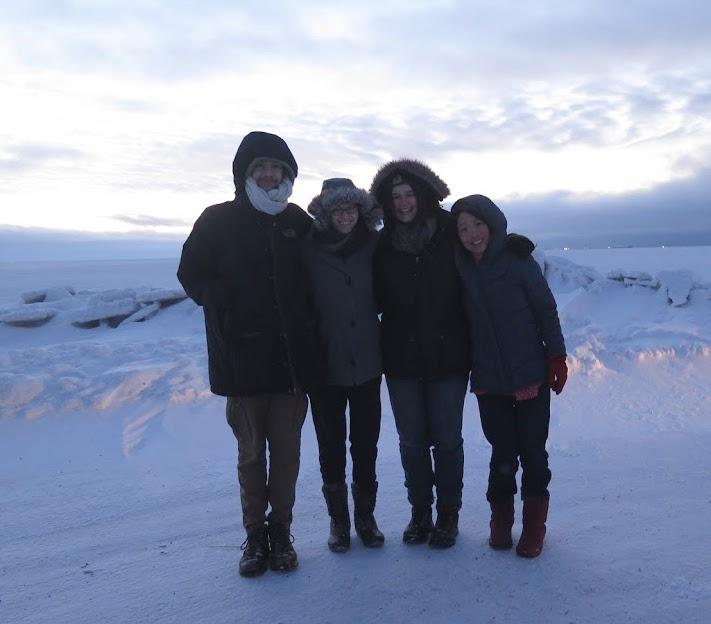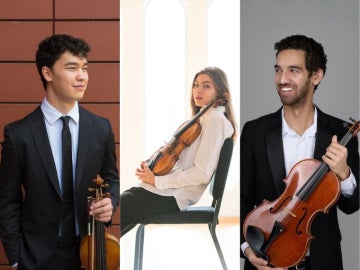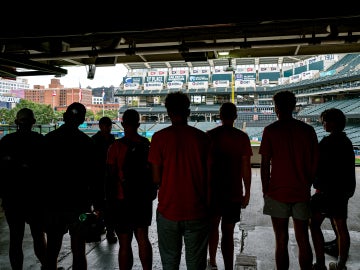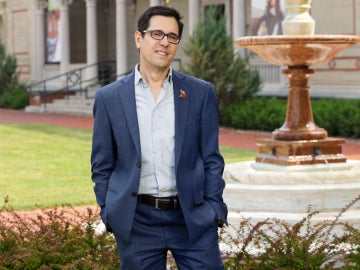Combating Climate Change and Exploring Resilience with the ‘People of the Whales’
February 21, 2017
Amanda Nagy

From left, environmental studies students Paulus Van Horne, Kiley Peterson, and Liv Roak, with Assistant Professor Chie Sakakibara at Point Barrow, Alaska.
Photo credit: Courtesy of Chie Sakakibara
Chie Sakakibara was a young graduate student and relatively new to the United States when she ventured to a remote Alaska town in the harsh Arctic climate to study cultural resilience of the indigenous population.
“I crossed the Arctic Circle without knowing anyone or having a place to stay because I was genuinely interested in human-animal relationships and the changing environment,” says Sakakibara, an assistant professor and one of the newest faculty members in the environmental studies program.
At 320 miles north of the Arctic Circle, the town of Utqiagvik, (formerly named Barrow) is considered ground zero for climate change because the Arctic experiences climate change at least twice as fast as the average rise on the rest of the planet.
Sakakibara came to the U.S. from Japan in 1998 for undergraduate work in Native American studies at the University of Oklahoma. She also has graduate degrees in cultural geography and art history. “[After graduating from college,] I ended up staying in the United States and switching academic fields here and there. Every time I switched my field, however, my research topic had to do with indigenous studies,” she says. Today, she teaches and researches in the field of environmental humanities.
She was drawn to the indigenous Iñupiaq culture in Alaska’s North Slope Borough because of their special relationship to the bowhead whales. The Iñupiat call themselves “the People of the Whales.”
“As a woman who grew up in Japan, the whale has been very special to me. The Iñupiat are very proud of their relationship with the bowhead whale, and that manifests in a variety of forms: hunting the whale, consuming the whale, sharing the whale with community members, and showing respect and appreciation of the animal that gives itself to the people. They don’t waste anything that comes out of the whale’s body. I find this form of reciprocity fascinating and beautiful. I participated in various cultural activities that are central to Iñupiaq lives. The more I spent time with them, the more I was warmly embraced. I wanted to know more about the people and work closely with them as an adopted community member.”
That was about 14 years ago. Sakakibara has forged lasting relationships with the Utqiagvik community, and they’ve witnessed her growth as an individual as much as a professional who is now mentoring a younger generation.
In November 2016, as the region was progressing into polar night, Sakakibara took three Oberlin students on a weeklong trip to Utqiagvik. Kiley Peterson, Liv Roak, and Paulus Van Horne had previously taken Sakakibara’s seminar, “Indigenous Peoples and Climate Change” and had interacted with Iñupiaq environmentalists Caroline Cannon and Rosemary Ahtuangaruak. During the visit, they met with villagers, participated in cultural activities, and ate the local delicacy called muktuk—the preserved skin and blubber of the bowhead whale.
Sakakibara says the concept of reciprocity has been a core of Iñupiat well-being for thousands of years. In the center, there has always been the existence of the bowhead whale. The whale meat and muktuk is a mainstay of their diet and provides the necessary calories and nutrients to survive the harsh climate; the sharing of the whale in the community and beyond has cultivated the cultural and social integrity of the People of the Whales. Cultural expression is tied to a cold Arctic climate that nurtures wildlife because traditional music is based on drums, which have been made from the liver and stomach lining of the bowhead whales and occasionally from caribou.
But warming temperatures and disappearing sea ice continuously threaten the animals’ and people’s connectivity, well-being and survival.
Snow and ice cool the earth’s surface by reflecting the majority of the sun’s energy back into the atmosphere. However, warming air temperatures melt snow and ice and expose darker regions (open water). As a result, the dark Arctic Ocean without any sea ice--which works as the reflector of the energy—absorbs more heat. This is how the Arctic is contributing to the warming of the planet as a whole. This phenomenon is known as the ice-albedo feedback, and is also interrelated with the polar amplification.
“The Arctic Ocean is supposed to be frozen nine to 10 months out of the year, but now the Arctic is locked onto a course of shrinking sea ice. The Arctic sea ice extent has broken record lows for winter in 2016 since the satellite records began in 1979,” Sakakibara says.
“What this means is that the sea ice is getting thinner and more fragile. Hunters use the sea ice as a foundation to tow, haul in and butcher the bowhead whale that they harvest in the ocean. The whale weighs up to one ton per foot. These are giant creatures that grow up to 60 feet in adulthood. If you hunt a bowhead whale, the ice has to sustain 60 tons of the dead animal, as well as the people from the community who are coming down to celebrate the arrival of the animal. So it’s getting very dangerous for the people to be on the sea ice to be with this sacred creature. The safety of the people and efficiency of butchering and sharing the animal is directly influenced by the warming of the sea and the atmosphere.”
Sakakibara’s collaborative research with the community explores cultural resilience of the People of the Whales at this time of environmental uncertainty and social anxiety. “The situation is constantly getting more challenging for the people. But, our study is not about the vulnerability of the society. Rather, we frame our exploration as a study of hope by exploring the people’s resilience and adaptation skills,” she says.
Upon completion of their fieldwork last fall, Sakakibara’s students are now formulating capstone research projects based on their experience.
Paulus Van Horne, a fifth-year double-degree student majoring in environmental studies and Technology in Music and the Related Arts (TIMARA), notes that the temperature over the Thanksgiving holiday was an unseasonably warm 9 degrees Fahrenheit. “The sea ice just didn’t form when it was supposed to. If you read through the online news sites, you’ll see increasing articles worrying about the lack of sea ice.”
Van Horne found inspiration in tribal radio station KBRW and other media in their role in whale hunting and connecting Iñupiaq villages across the vast expanse of the North Slope Borough. “What I found is that Facebook has largely supplanted KBRW's community role. It is two-way conversation after all, and you can send pictures. It totally beats radio in that respect. My research will focus on how the Iñupiaq people have demonstrated cultural resiliency by reappropriating communication technology to transmit cultural material--language programs, Eskimo dance recordings, stories and folklore--regardless of the technology. So I will trace Iñupiaq resilience through changing technology and climate.”
Fourth-year environmental studies major Kiley Petersen was awestruck by the welcoming nature of the Iñupiaq villagers. “Something I heard mentioned both in the Anchorage airport and by members of the community in Utqiagvik was the intense pull of the Arctic and Alaska itself—there's just something very comforting but at the same time stark about the landscape that, combined with the strong sense of community, makes it a very compelling place.”
Petersen, who is from Minneapolis, is interested in journalism and public policy, and she says the trip confirmed her desire to integrate environmental and indigenous concerns in those fields. “While I was there, I found myself drawn to research about native food and subsistence hunting, collaboration between whale biologists and whaling crews, and the formation of the Alaska Eskimo Whaling Commission to advocate for native whaling rights on an international scale.”
Liv Roak, a fourth-year environmental studies major and sociology minor, came away with a particular interest in how song and dance permeate community life in Utqiagvik.
“We had the privilege of engaging in various communal activities and cultural practices, such as the community Thanksgiving feast and Eskimo Dance, to gain experience of how the Iñupiat people live and thrive in the Arctic. It became evident during my time there that music is a powerful tool for expression of Iñupiat identity, community, and cultural resilience in the face of the ongoing legacies of settler colonialism, particularly climate change,” says Roak, who is from Philadelphia.
The art of reciprocity
When Sakakibara interviewed at Oberlin for her current position two years ago, she casually mentioned her desire to curate an art exhibition based on human-animal relationships. Almost as soon as she arrived, Liliana Milkova, curator of academic programs at the Allen Memorial Art Museum, helped make it happen.
“Exploring Reciprocity: The Power of Animals in Non-Western Art,” opened in late January. The exhibition is linked to two of her classes, Nature, Culture, Interpretation (ENVS201) and Indigenous Environmentalism (ENVS327) in which students explore how nature is experienced and interpreted in non-Western traditions through an interdisciplinary humanities lens. It includes 18 works of art from the museum’s collection, half coming from Native American traditions, the other half composed of Japanese woodblock prints—ukiyoe—from the 18th and 19th centuries.
While this exhibition does not include any maps, as a cultural geographer-art historian, Sakakibara frames it as an attempt of counter-mapping. Counter-mapping signifies the efforts of underrepresented communities to map against dominant power structures and systems. This attempt often results in social and cultural empowerment and enhancement of sovereignty. Highlighting the works by non-Western artists, the exhibition reveals the human-animal relations as a metaphor of such initiatives of “mapping back” the world. Artists have long turned to visual texts to grapple with marginalization, colonialism and imperialism. Furthermore, artworks served as a tool of communication between the West and non-Western spheres of the world.
In conjunction with the exhibition, Sakakibara has organized several events and guest lectures by her collaborators. Among those is a panel discussion on animals in Western and non-Western imaginations on March 2 at the museum. The event will include talks on specific animals by faculty members Matt Senior (French), Mary Garvin (biology), Tom Newlin (Russian), Karl Offen (environmental studies), and third-year environmental studies student Sam Tunick, a curatorial assistant for the exhibition and Sakakibara’s collaborator.
Artist and art historian Edward Hummingbird of Albuquerque’s Southwestern Indian Polytechnic Institute will give a lecture entitled “American Indian Artist Perspectives of Culture and Environment” March 8. On March 25, Aaron A. Fox, associate professor of music and director of the Center for Ethnomusicology at Columbia University, will speak on "Ways of Hearing: Decolonizing the Ethnomusicological Archive.” Fox is the keynote speaker for the Meeting of Midwest Chapter of the Society for Ethnomusicology organized by Jennifer Fraser, associate professor of ethnomusicology. Fox and Sakakibara have been collaborating on a project to return and recover Iñupiaq recordings previously held by Columbia University’s Center for Ethnomusicology.
Sakakibara is grateful for the interest and support from her colleagues and students, and appreciates interdisciplinary collaboration with various departments and programs across campus.
“It was always my dream to curate my own art exhibition, work on it with students, and then incorporate it in my teaching and research. The current exhibition also highlights my commitment and affiliation with the Iñupiaq and Japanese communities. Being at Oberlin has given me an invaluable opportunity to be thankful to everyone who has helped me grow up as a person as much as a scholar. Being at Oberlin also gives me an opportunity to pay it forward by working closely with students. This reciprocity is coming into a beautiful circle, and I’m very appreciative of every moment of my time here.”
You may also like…
Oberlin Students Selected for Prestigious New York String Orchestra Seminar
Directed by Oberlin artist in residence Jaime Laredo, intensive 10-day experience culminates in performances at famed Carnegie Hall.
Oberlin Adds Sport Studies and Management Integrative Concentration
Sport is many things: a vehicle for personal inspiration and identity formation, a catalyst for social change, an economic driver, and a contributor to health and well-being. Given all this, sport is...
Interview: Jon Seydl, John G.W. Cowles Director of the Allen Memorial Art Museum
Get to know Jon Seydl, the new John G.W. Cowles Director of the Allen Memorial Art Museum at Oberlin.


